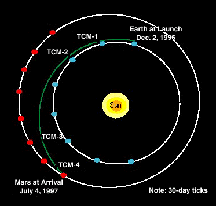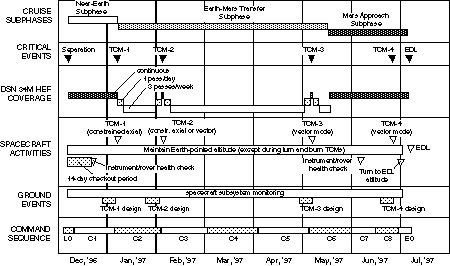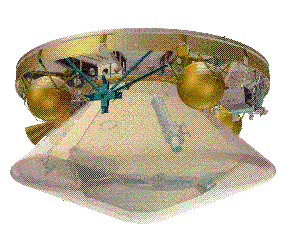
Mars Pathfinder Cruise And Mars Approach Activities

Launch And Injection
The cruise phase of the Mars Pathfinder Mission begins with successful
launch atop a Delta II rocket from the Kennedy Space Center in Florida in December
of 1996. Once in earth orbit, the spacecraft is given a final boost with
the help of a solid-fuel rocket motor. This 'kick-stage' gives the spacecraft
just the right amount of velocity increase it needs to escape Earth's gravity
and enter its own orbit around the Sun. Once spent, the third stage is jettisoned,
and we can officially say we are on our way to Mars.
At separation from the upper stage, the spacecraft is in Earth's shadow
and spinning at 20 rpm. An onboard sequence of events is activated once
the separation microswitch detects that separation is completed. The Deep Space Network (DSN) initiates
spacecraft acquisition and lockup activities using a 34-Meter antenna located
in the California desert. As soon as acquisition has occurred, the engineering
telemetry broadcast by the spacecraft is received on the ground at a rate
of 40 bits per second (b/s). This telemetry is a combination of real time
engineering data and stored data from launch, separation, and Earth/Sun
acquisition. Any attitude errors are corrected after Earth communications
are established. If communications are not established within a set time
period, then a contingency acquisition sequence is executed autonomously
by the spacecraft.
The spacecraft automatically determines its orientation in space by first
determining the location of the Sun with respect to the spin axis of the
spacecraft using a Sun sensor located on the top of the cruise stage. This
procedure, known as Sun acquisition, will provide the spacecraft with the
information it needs to reduce the spin rate from 20 rpm to a nominal 2
rpm. After the spacecraft has cleared the moon's orbit and safely spun down
to 2 rpm, the star scanner will be activated. After star identification
has been confirmed, the Attitude And Information Management (AIM) computer
will then calculate the spacecraft orientation. Once the attitude is determined,
the spacecraft can be commanded to change its attitude and move the spin
axis closer to Earth if needed.
The Interplanetary Path To Mars
Mars Pathfinder uses an Earth-Mars transfer orbit with a launch period
starting on December 2nd, 1996 and ending on December 31st. Regardless of
the launch date, the spacecraft is scheduled to arrive on Mars on July 4th,
1997. The total flight time from Earth to Mars takes 6 to 7 months, depending
on the launch date. The figure below shows a view of the interplanetary
trajectory as it would look from above the Sun.
 Mars Pathfinder Trajectory
Mars Pathfinder Trajectory
Spacecraft Activities During Cruise
During the 7-month cruise to Mars, a number of activities are performed
to maintain the health of the entry vehicle, lander and Rover. Navigation
is required to maintain the flight path, and the various spacecraft subsystems
are monitored and adjusted as needed to keep them operating at peak efficiency.
The table below shows the timeline of events from launch to Entry, Descent
And Landing (EDL) at Mars.
 Mars Pathfinder Cruise Timeline
Mars Pathfinder Cruise Timeline
Cruise activities begin once we are safely out of Earth orbit. After
the attitude is established and the spacecraft is determined to be healthy,
the flight team begins a two-week initial characterization and calibration
period. Systems to be characterized include the solar array and battery,
thermal control, attitude determination and control, and the communication
subsystems. The primary spacecraft activities during the first month of
cruise are collection and downlink of relevant engineering telemetry and
tracking data, initial spacecraft health checks and calibrations, and attitude
maneuvers to maintain the correct Earth/Sun geometry. One health check of
the Rover and Science
Instruments occurs at launch + 15 days.
Measurements of the spacecraft range to Earth and the rate of change
of this distance are collected during every DSN station contact and sent
to the navigation specialists of the flight team for analysis. They use
this data to determine the true path the spacecraft is flying, and determine
corrective maneuvers needed to maintain the desired trajectory. The first
of four Trajectory Correction Maneuvers (TCMs) is scheduled on January 4th,
1997 to correct any errors collected from launch. The magnitude of this
maneuver is less than 75 meters per second (m/s). Navigation is an ongoing
activity that will continue until the spacecraft enters the atmosphere of
Mars.
After TCM-1, the flight team transition from a 'spacecraft checkout mode'
to a more routine 'spacecraft monitoring mode'. DSN tracking coverage is
reduced from 3 contacts a day to 3 per week. Spacecraft health and performance
telemetry is downlinked at 40 b/s or greater during each tracking pass.
A key activity during cruise is the designing and building of command
sequences that dictate to the spacecraft how it is to perform each of the
activities required. Each cruise command sequence is generated and uplinked
approximately once every four weeks during one of the regularly scheduled
DSN passes. The uplink generation process requires 14 days for planning,
sequence generation, verification, and commanding.
Two more trajectory correction maneuvers are performed in early February
and early May to further reduce navigation guidance errors. TCM-2 requires
less than 10 m/s , and TCM-3 is smaller still, less than 1 m/s. These two
maneuvers further reduce any guidance error detected from navigation measurements.
Mars Approach Activities

Starting 45 days prior to entry, tracking is increased to 3 passes a
day and the flight team steps up its preparation for atmosphere entry and
landing. A final health and status check of the instruments and Rover is
performed at Mars-30 days. A fourth and final trim maneuver is performed
at M-10 days (June 24th), requiring less than 0.50 m/s. At M-5 days, the
spacecraft performs a turn to the entry attitude, where it will remain until
atmosphere entry. The roll thrusters increase the spacecraft spin rate from
2 to 10 rpm for entry. At that time, the cruise phase ends and the flight
team transitions to the entry, landing, and surface operations phases.
During the final day of approach, the navigation team is producing orbit
solutions on a regular basis, and adjustments are made to the computer programs
that determine when the parachute should be deployed. At 6 hours out, the
final adjustment is made, and the flight team makes final preparations for
atmosphere entry.
Back to the Mars Pathfinder Home Page.